
Furry Gondwana
The Mammals, latecomers
to Gondwana
M ammals began their golden age in the Tertiary period, well after Gondwana had lost its supercontinent status and started splitting apart. Therefore, the larger fragments all had long periods where they existed in isolation, and during which the early mammals living there could evolve along distinct lineages. The situation became more complex, however, when the continents we know today gradually began to restore connections as their motions continued. India, and to a lesser degree, Africa, joined Eurasia; and South America became tenuously connected to North America, and, during glacial periods, to Asia as well, via land bridges across the Bering Strait. These changes allowed for a significant mixing of formerly diverse mammal populations, such that the casual observation of wildlife in various parts of the World doesn't do much to give one a clear picture of the ancient past. Of course, there are many reasons to appreciate the various creatures we share our World with, especially the charismatic mammals, so such deficiencies are not really relevant.
A Home Apart
One piece of the Gondwanan family that has remained
largely biologically isolated since the breakup is Australia, or, more
precisely, Australia-New Guinea. That fact has allowed the
Marsupials to make that continent their stronghold, and diversify into one of the more pleasing mammal lines to be found anywhere. The stars of the class are the famous hoppers of the family Macropodidae, the Kangaroos, Wallabies, Pademelons, and Tree Kangaroos, plus a few others. There is not a great distinction between the major groups of the family, for example between Kangaroos and Wallabies, apart from differences in size and certain superficial aspects. So it can often be difficult for an unaccustomed observer, like me, to tell who is who among the various members of the family, especially since sightings can be rather brief. Below are some of the smaller examples I saw during the Tour. Some of these species live in large groups, such as certian Wallabies, and occasionally surprising such a cluster by quietly cycling up to their feeding grounds created some of the more enjoyable experiences of my time in Australia, as the energetic, but rather skittish, creatures bounced off in every direction at high speed upon detecting my approach. The more solitary members of the group proved to be much more difficult to see and even more challenging to photograph. The captive examples below provided the only real chance I had to secure any decent images of those species.
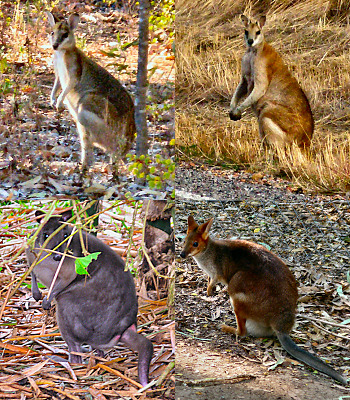
Wallaby, Australia | Wallaby, Australia Row 1
Forest Wallaby (captive), PNG | Pademelon (captive), Qld, Aus. Row 2
The Kangaroos, apart from the appealing Tree Kangaroo, which I was not fortunate enough to see in the wild, were much easier to observe, especially in the northern and western parts of the continent. While I was able to see them on many occasions, getting a decent photograph was still far from a certainty. That was due to their often-shy disposition and especially their unique mode of locomotion, which gives them the ability to disappear into the bush at an incredible rate. I should not complain about that, however, since seeing them almost effortlessly hop along provided me many fascinating encounters. Watching a 'Roo leap over a fence in a single bounce, as if it wasn't there, was a true thing of beauty.
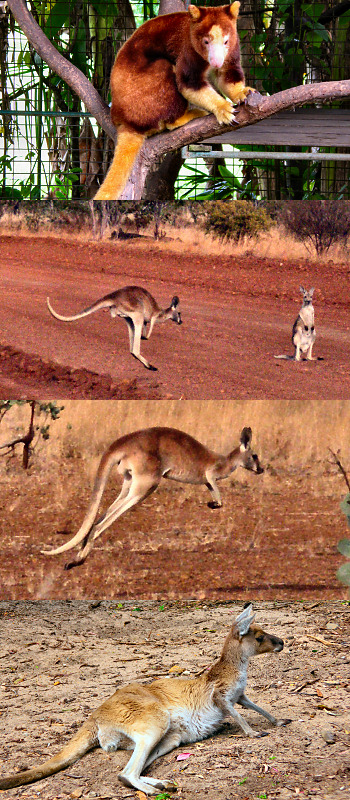
Tree Kangaroo (captive), PNG Row 1
Kangaroo & Joey, N.T., Australia Row 2
Kangaroo, N.T. Australia Row 3
Kangaroo, Western Australia Row 4
The rest of the Marsupial clan proved to be even more difficult to see. Despite my efforts to focus my attention towards the treetops, a practice that is most definitely not recommended for cyclists, I failed to see any of the continent's iconic Koalas in the wild. That is probably understandable as I believe that, given their preference for eucalyptus leaves and their typically slothful lifestyle, all one usually sees is a motionless ball of fur high in the trees, unless one is very lucky. The most appealing chance I had to see the adorable creatures was at the Phillip Island Koala Sanctuary in
Victoria, where rescued Koalas live in an enclosure that resembles their natural habitat fairy closely. Unfortunately, for various reasons, such as scarcity or nocturnal behavior, I did not get to see some of the other unique animals of the continent, notably the Platypus. The only live Wombat I saw was at an animal park in Queensland. There were, however, many misfortunate members of that inoffensive species that I saw lifeless on the roadside, most often in Tasmania, after having been flattened by inconsiderate automobile users, a fact that disturbed me quite a bit.
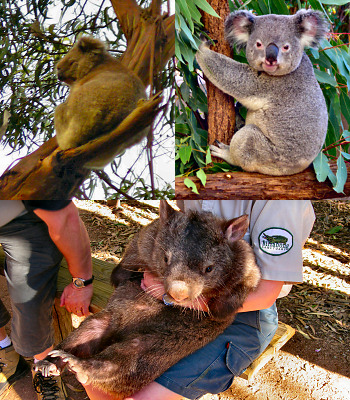
Koala (sanctuary), Vic. Australia | Koala (captive) Qld. Australia Row 1
Wombat (captive), Qld. Australia Row 2
True Long-Distance Travelers
In a rather odd situation, the Camelids represent a family of mammals that is usually thought off as being from the Gondwanan region, but which actually evolved on North America. There, the various types of Camels have been extinct for some time, but other examples exist today in three general groups in other regions, two of which are Gondwanan. The two-humped Bactrian Camels, live in Central Asia, which was, unfortunately, not on my route, while the more familiar Dromedary Camels are found from South Asia through to Northern Africa. While there are a small numbers of Bactrians living in the wild, most are domestic animals, as are essentially all of the Dromedary Camels. For the most part they are used for carrying cargo, and are still used for that purpose surprisingly often in certain places.
Most of my encounters with Dromedary Camels came in Ethiopia and Kenya, and it did not take me long to realize that I quite enjoyed sharing the road with them. In spite of the heavy loads they were often forced to carry, I found them to be generally good-tempered and easy going, even when being surprised by an odd-looking creature like me. Additionally, they didn't seem to make a mess of the place, especially the road surface, as most of the other large domestic mammals usually do. That fact alone made them one of my favorites. Though, I was vaguely aware of the situation before the Tour, I was a little surprised at just how extensive the population of feral Dromedary Camels in Australia has become. Camels were originally brought to the country in the 19th century to aid in establishing outposts in the vast, dry center of the continent. Once their usefulness was no longer apparent, they were released, and have developed a rather large population, in fact they now represent the only significant population of wild Camels of that type.

Camels, Ethiopia Row 1
Camels, Kenya Row 2
Camel and Camel-shaped hill, Australia Row 3
Camels, Australia Row 4
In the Western Hemisphere, the modern members of
the family live exclusively in South America, and consist of four species, all of which are considerably smaller than their Old World counterparts. Two of those, the Llama and the Alpaca, have also become solely domesticated species. The Llama being used as a pack animal, and the Alpaca as a source of fibers for fabric. Both are a source of nutritious meat as well. Neither has ever been successfully used to carry people for transportation, or for other agricultural uses, unlike their domesticated counterparts in the eastern hemisphere. The two species are rather similar with the Alpacas being a little smaller and considerably shaggier, which makes them a little difficult to tell apart. As far as I could tell, the Llamas were the type that I encountered most of the time along my route, starting in extreme northwestern Argentina, through Ecuador.
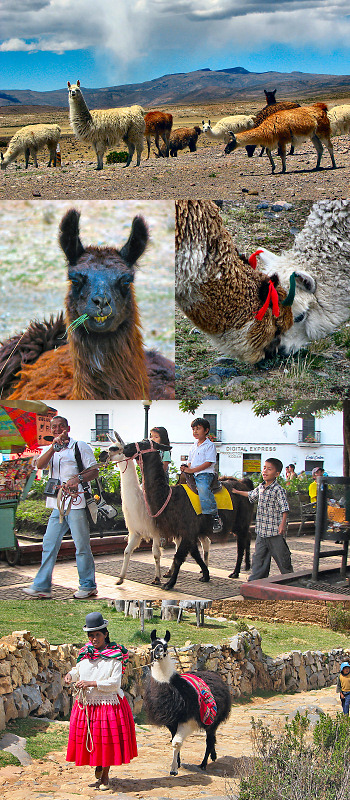
Llamas, Bolivia Row 1
Llama, Argentina | Llamas, Peru Row 2
Llamas give rides to kids, Colombia Row 3
A Woman with her Llama, Isla del Sol, Bolivia Row 4
The two remaining wild Camelids in South America both live in the colder, or mountainous, regions of the continent. The smaller of the two, the Vicuņa has made a significant, but incomplete, recovery from the critically endangered status it held in the middle of the last century. Formerly prized for their fine wool, they now mainly live in protected areas. I saw several family groups in two reserves along the road between Abancay and Nasca, Peru. They are attractive creatures who run swiftly, while keeping a distinctly graceful stature.
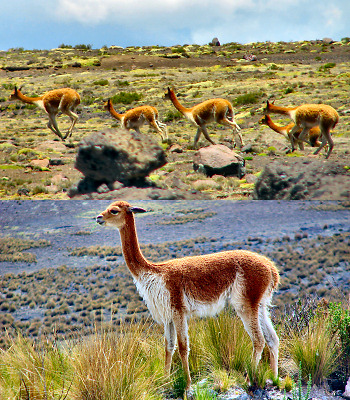
Vicunas in Peru
A little more common are the Guanacos, which are primarily found in the chilly, windblown region of Patagonia. In fact, without much else there to occupy one's attention when riding through that part of the World, watching them is one of the things that keep touring cyclists sane, at least in my case. I particularly enjoyed their social antics, vocalizations that sound like laughter, and the way that they could jump a fence with ease, which reminded me of the 'Roos I had seen earlier in the Tour. The Guanacos are perhaps the most nervous of the Camelids, and when potential danger, such as a strange cyclist, approaches, the leader of the heard makes its way to the highest ground in the area, from where warnings are barked out to the rest of the group. All of these aspects made them one of my favorite animals that I saw during the Tour.

Guanacos in Argentina
This Guanaco watched my passing from a high vantage point nearby, and so doing provided one of my favorite images of South America.

A Guanaco Sentinal in Patagonia
Large Creatures for Large Lands
Members of the Elephant family, from the order Proboscidea had previously lived in many different parts of the World. However, today the family is only represented on two continents, Africa and the southern part of Asia, meaning it is restricted, more or less, to parts of the former supercontinent. The Asian Elephant has been significantly affected by the large human presence in that part of the World. In addition to habitat loss, a large fraction of the species' population has been drafted as laborers, moving heavy objects, or carrying cargo, not to mention their use as entertainment for tourists. While it is probably not the Elephant's choice to participate in such activities, it certainly is an amazing sight to come across a working animal of that size unexpectedly while cycling. I have, of course, heard a loud rustling sound coming from the roadside bushes on many occasions, only to have its source revealed moments later to be a cow munching away. However, when such a rustling sound turns out to be an elephant intent on sharing the road with someone like me, well, that is an experience not soon forgotten.

Working Asian Elephants, Laos Row 1
Heavy traffic in Laos Row 2
Working Asian Elephant, Royal Chitwan N.P., Nepal Row 3
Elephants on the move, Royal Chitwan N.P., Nepal Row 4
Seeing wild Asian Elephants is not an easy task, especially when on a bicycle tour. However, I got very lucky and came across this group of pachyderms making use of a roadside mud hole, while I was on my way out of Khao Yai National Park in Thailand.

Wild Asian Elephants in Khao Yai National Park, Thailand
In Africa, the larger African Elephants are more widespread, and still show reasonable numbers in the wild. Though they are most easily seen in the various game reserves, it is not uncommon to encounter them in other areas. That happened to me on two occasions, one just outside of Meru, Kenya where at least two were browsing in the trees right alongside the main highway, and later in Botswana, where, in a rather thrilling event, a family slowly walked right past my tent in the hours just after sunset. Taking decent photographs is significantly easier in one of the game parks, however, and the images below were all obtained in such a manner.
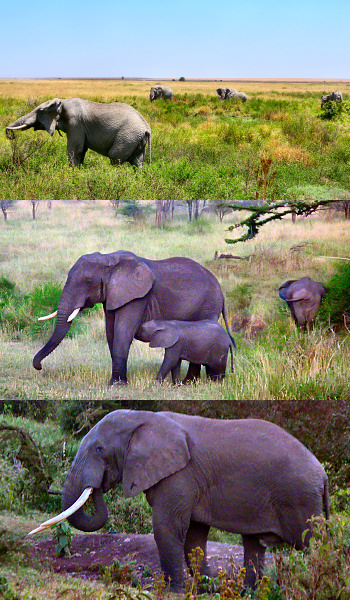
African Elephants, Serengeti N.P., Tanzania Row 1
African Elephants, Serengeti N.P., Tanzania Row 2
African Elephants, Ngorongoro, N.P., Tanzania Row 3
This particular image was taken during my cycling safari at Mashatu Game Reserve, although it is not obvious, I, and my guide, had just outrun a pair of juvenile elephants who were charging back to their main herd. That was certainly one of the most unique and exciting cycling experiences of the Tour, and my entire life, I suppose.
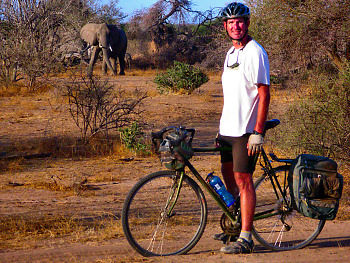
Me and an Elephant in Mashatu Game Reserve, Botswana
Rhinoceros, like Elephants, used to be significantly more widespread, but their ranges are now also reduced to South Asia and Africa. However, they are confined to parks even more so than their larger counterparts, making their observation on a tour even more difficult. That may not be a bad thing, since their disposition is famously terse. My encounters came in Royal Chitwan National Park, in Nepal, where I was seated safely on the back of an Elephant, and in Ngorongoro Crater, Tanzania, where I was unhappily encased an a Land Rover.

Asian Rhinocerous in Royal Chitwan N.P., Nepal Row 1
Black Rhinocerous in Ngorongoro N.P., Tanzania Row 2
The Life of the Plains
Giraffe are perhaps my favorite example of the
African megafauna, and I was thrilled that they were the first of the big African species that I encountered. That was even more exciting given that I was alone at the time, on a dusty road in northern Kenya, and I had not expected such a sighting at that time. Nevertheless, after I heard some decidedly loud rumbling in the nearby bush, caused by the tremendous weight of their hoof falls, I looked forward and soon saw a family of six of the tall animals saunter across the road in front of me. Other encounters came during safaris later on, but perhaps the best of all was just as I arrived at Mashatu for my cycling safari, when, even before I had reached the Lodge to begin my safari, I surprised a group of at least fifteen Giraffe who proceeded to gallop away, once again right across the road before me, making a thundering racket. Unfortunately, that event passed too quickly for me to record any images of the herd.
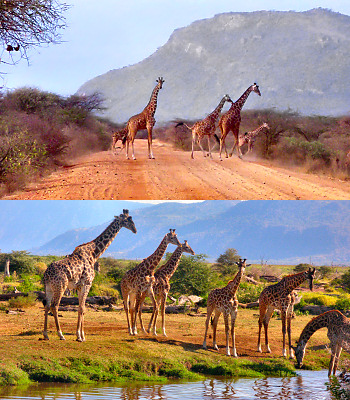
Giraffes in northern Kenya Row 1
Giraffes in Lake Manyara N.P., Tanzania Row 2
The grazing herbivores of Africa were also a highlight, though in their case I did not encounter any outside of the game parks as well. Even though the timing of my arrival in the region did not coincide with the famous migrations of the great herds, there was still a nice selection to be seen.
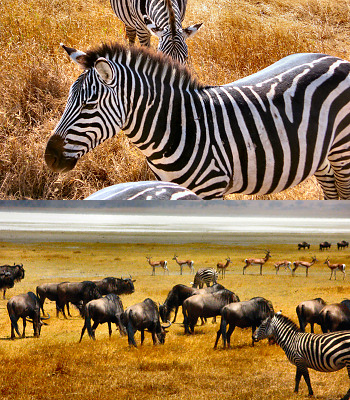
Zebra, Ngorongoro N.P., Tanzania Row 1
Herbivores in Ngorongoro N.P., Tanzania Row 2

Thompson's Gazelle, Tanzania | Grant's Gazelle, Tanzania Row 1
Impala, Tanzania | Kongoni (Hartebeest), Tanzania Row 2
Topi, Tanzania Row 3
Perhaps one of the few disappointments of my wildlife viewing during the Tour was related to the big cats. In that case, the two lionesses I saw in Ngorongoro, shown below, were the best I could manage. Which was too bad, as I would also have liked to have seen a leopard, jaguar, or any of the others out there.

Lions in Ngorongoro Crater, Tanzania
Evolution's Marvels
Now I skip back to South America, which, though there are no longer any megafauna present, still has some interesting mammals to see. One thing that particularly impressed me was the presence of various large rodents which visually demonstrate the evolutionary linkages between that group and the hoofed mammals. Those included some small, but relatively tall, species of Agouti, the Mara, formerly known as the "Patagonian Hare", but which actually belongs to the family Caviidae, along with the final example, the Capybaras, the World's largest rodent. The extended hind foot, and toe-walking stature, which increase the height of the animal, are clearly seen in the first two cases, while all of the animals shown below, especially the surprisingly dignified Capybaras, exhibit a thick, extended snout, reminiscent of horses. Noticing that type of relationship between various living creatures is something I find extremely satisfying.

Agouti, Pantanal, Brazil Row 1
Patagonian Mara, Argentina Row 2
Capybaras, Brazil Row 3
Capybaras, Brazil Row 4
Though the mammals are the last of the major classes of animals to have widely diversified, there has still been sufficient time for many of their kind to have gone extinct. Notable among those are most of the mammalian megafauna which lived outside of Africa. Below are a few indications of what once was, including the skull of a Diprotodon, a type of giant Wombat from Australia, the shell of a Glyptodont, basically a huge Armadillo from south America, and finally a replica of a Mylodon a giant Ground Sloth, also from South America. I agree with the idea that the spread of humans around the globe was a primary cause of their demise, and I certainly think that is a shame, because if these types of creatures were still with us today, the World would be an even more fascinating place.

Fossilized Diprotodon Skull, Australia Row 1
Fossilized Glyptodont Shell, Uruguay Row 2
Mylodon Replica, Chile Row 3
The World of Primates
I did not manage to see any of the Great Apes, during the Tour, and I am still very annoyed with myself for bypassing the opportunity to take a gorilla-spotting trek when I was in Rwanda. However, there were plenty of our smaller primate cousins to fill the void. Among my favorite were the Lemurs, of the suborder Strepsirrhini, which inhabit the biologically splendid Gondwanan island of Madagascar. After my two tours on the island I have managed to see eleven different species in the wild, though some encounters were more satisfying than others. Most of the diurnal Lemurs are very active and zip around among the trees with impressive alacrity, and, of course, the many nocturnal species are equally challenging to observe. Every so often, one will demonstrate that they are as curious about us as we are towards them, and jump onto a nearby tree to look their observers straight in the eye with a penetrating glance. In those cases, our shared primate heritage is readily apparent. If I am fortunate, I will one day be able to add to my species count for this compelling family.

Mouse Lemur | Broad-Nosed Bamboo Lemur Row 1
Red Fronted Lemur | Verreaux's Sifaka Row 2
Red-Bellied Lemurs Row 3
In South Asia, monkeys are more adapted to life among humans than anywhere else I've been, and many colonies live around the numerous temples throughout the region, where they are mostly left in peace. However, it was my observation that, with the possible exception of the Langurs, the Monkeys of Asia possess especially unpleasant personalities, often snarling, or shouting at passersby, rummaging through unattended belongings, and generally making a nuisance of themselves.
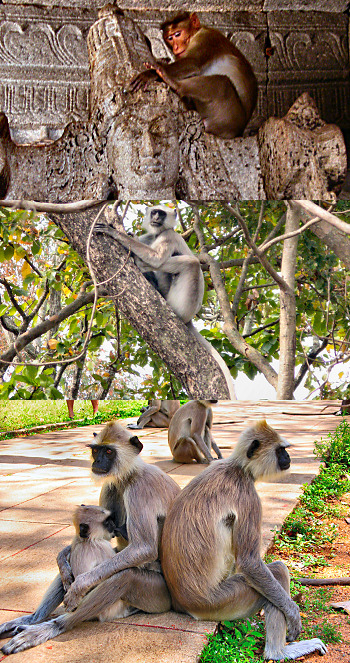
Macaque, India Row 1
Langur, Nepal Row 2
A family of Langurs relaxing, Sri Lanka Row 3
African monkeys are usually seen only in parks or reserves, and behave a little more cautiously towards humans. The largest member of the family that I observed was an impressive troop of Gelada Baboons in Ethiopia, which are not true Baboons, but considered to be a separate genus. Chimps, Bonobos, and Gorillas, unfortunately, could not be seen along most of my route.
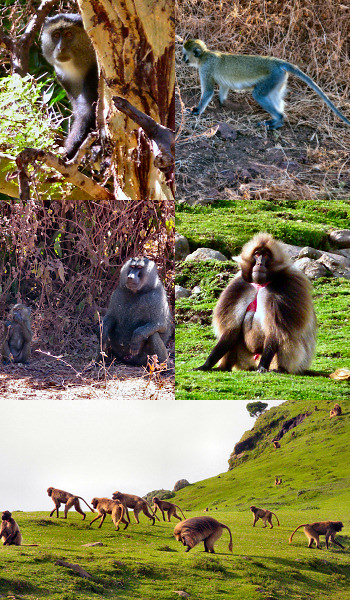
Blue Monkey, Tanzania | Vervet Monkey, Lake Manyara N.P., Tanz. Row 1
Olive Baboon, & baby, Tanzania. | Male Gelada Baboon; Ethiopia Row 2
Gelada Baboon Troop, Ethiopia Row 3
The New World Monkeys, present throughout the tropical regions of South and Central America, displayed a much more pleasant attitude than their eastern hemisphere cousins. Most could be watched for an adequate length of time without causing any sort of a panic among their group. In the eastern part of the continent, the only species I saw were small marmosets, though they were certainly entertaining. The more interesting species were encountered during my side trip to the Peruvian Amazon. Those included a large group of semi-tame monkeys that live in the forest around the Yarapa River Lodge. Their welcoming, curious nature was a nice counterpoint to some of the snarling Macaques I met in Asia.
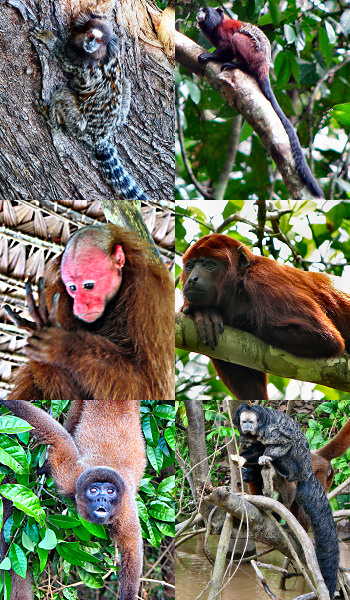
Common Marmoset, Brazil | Saddleback Tamarin, Peru Row 1
Red-Faced Ukari (rescued), Peru | Red Howler Monkey (resc.), Peru Row 2
Woolly Monkey, Peru | Monk Saki, Peru Row 3
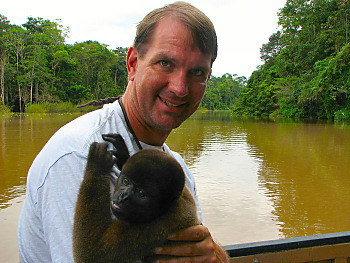
Me and a friend at the Yarapa River
Out of Gondwana
Of course, Gondwana was also the birthplace of a certain unique family of primates, comprising the genus Homo. Our earliest ancestors walked the same plains in Africa that later supported my wheels. It is that particular primate, of course, that has made observing all of the other mammals, not to mention the rest of the animal kingdom, a lot more challenging than it would otherwise be. Today our earliest ancestors can only be met by examining fossils like the Australopithicus skull shown below, seen in the Cradle of Humanity Museum near Johannesburg, South Africa. It is not entirely clear that all of the wonderful creatures that I saw on the Tour will avoid a similar fate to the species that have previously vanished at the hands of that one special primate.
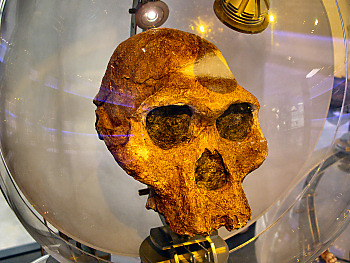
An Australopithicus Skull, at the Cradle of Humanity Museum,
Sterkfonien Caves, South Africa
Previous | Next
Main Index | Pre-Tour Index
Post-Tour Index | Articles Index
Slideshows
Main Index Pre-Tour Post-Tour Articles Previous Next |
Observing Mammals
Looking at this page, it might seem that the southern continents are overflowing with large mammals. In a certain sense, that is true. On just about every cycling day of the Tour I encountered at least one warm-blooded creature, usually one more massive than myself. Almost all of those were cows. Those that weren't were sheep, or, less frequently, goats. Those three species are the primary hebivores on almost all of the most productive grasslands on Earth, as well as a fair percentage of the forests, swamps, and arid environments. When one is cycling along, and hears a large rustling in the bushes nearby, it is almost certainly a cow. Seeing any of the more charismatic large mammals in the wild is a rare event indeed, and when one is encountered it is a thing to be greatly appreciated. However, on a very long tour, one which includes fairly remote areas, the chances of a few such meetings, at some point, increase quiet a bit. The Giraffes I saw in Kenya, and the Guanacos of Patagonia, were probably the best unexpected sightings I made during the Tour, and rank high among my list of favorite experiences.
To see wild mammals with some certainty, and in large numbers, it is usually necessary to venture into some type of large protected area. That unfortunate limitation can be tricky at best when on a tour, and may often be close to impossible. It is worth the effort, however, as there are few other experiences that can compare today. However. the number of such areas in which success is guaranteed is disappointingly small. In Australia Kangaroos and Wallabies can be seen in both parks and in the open bush, though patience can be required as they rarely group in large numbers. South Asia has few places apart from a small number of scattered reserves where large mammals can be seen, and so I made very few sightings during Stage 2. Africa is unquestionably the best place left to see mammals, though many of the continent's big parks, such as Amboseli, Serengeti, Selous, and Kruger are not open to bicycles. Private game parks can also provide a nice selection of wildlife, but with the exception of Mashatu, in Botswana, where I did an excellent cycling safari, few of those allow bicycles as well. In the Americas, there are surprisingly few good locations for viewing large mammals. In the south, the Patagonian steppes, and the above-mentioned Guanacos found there, are perhaps the best, while the Amazon basin, which still contains a lot of wildlife, reveals is residents only to those with great patience and a keen eye. In the north, apart from the odd Bison ranch, which isn't really a wild game experience, Yellowstone is perhaps the only place that can give a similar experience to the African parks.